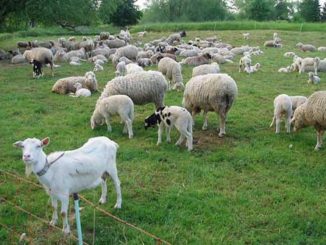In Ladakh region of India, sheep and goat rearing is the core activity of rural masses and plays a vital role in socio- economic upliftment of weaker sections of the society. Sheep play an important role in the hilly and other inaccessible areas where it is difficult for other livestock to thrive and contribute to the income of poor communities. Keeping up with the constraints in the region, sheep and goats sustain food and economic security.
Purgi sheep is a native sheep breed of Kargil region of Ladakh. Purgi or puriki is basically a language spoken by the Purikpa tribe in parts of the Indian union territory of Ladakh and neighboring regions. This breed derived its name from a language of purikpa tribe. This sheep is a native breed of Kargil region of Ladakh, it is locally called as Purgi sheep. This sheep is mainly reared by a rural tribal people of Kargil and were reared under range system in summers and semi-intensive system in winters.
Breed characteristic
Purgi is a small-sized, indigenous, undocumented sheep found in Kargil area of Ladakh . Purgi sheep is predominantly white in colour. Other colours like brown, black, black and white, brown and white are also found. This breed is having long pointed flat head, short and slightly tubular ears and having different horn patterns like curved C shape, curved downward and curved forwards. The body weight is higher in females than their counter parts, and attain adult body weight of about 25-30 kg in females and 24-28kg in males. Breed is having short and strong leg which help them to climb the mountainous area during grazing It was inferred that the Purgi sheep are hardy, able to tolerate harsh winters of cold arid region. They have got a good source of genetic resource under the prevailing environmental conditions.
Utility
The sheep population of Kargil district was 1, 13,538. Majority of the Kargil sheep breeds are indigenous. Rearing of sheep has been traditionally in the hand of weaker segment of society and nomadic people of the country. They contribute greatly to the agrarian economy, especially in the arid/semi-arid and mountainous areas where crop and /or dairy farming are not economical. It fetches better market price during severe winter when Kargil remains cut off from the rest of India. Breed is very important in terms of meat, milk and fiber.
Almost every household is having 5-10 sheep. Some farmer is having upto 50 sheep. Average wool production from purgi sheep is 1-1.5kg. The wool is used for weaving of the woollen products. Each family is having sufficient raw wool and they do not need to procure it from any other source. But they have no market for raw wool, so they convert it into various woolen products by traditional methods. Most of the handloom in Kargil serve the need of the local people. For many it’s the main source of earning livelihood. Handloom weaving is one of the main activity of nomadic people of Kargil district of Ladakh region. Weaving becomes their chief occupational priority especially during harsh winter season when they have no agricultural related work to do. The weavers, especially women folk, follow their ancestral traditional methods for converting raw wool in to various woollen handloom products. These handloom products full fill their local needs, help them to improve their financial savings and thus empower themselves. These animals provide income, employment and food security to the resource poor farmers and people of the area i.e. fetches better market during severe winter when kargil remains cut off from rest of india.
Conclusion
Since these breeds are most suitable to the local climatic stress and harsh environmental conditions prevailing in the area throughout the year, so there is need to conserve these indigenous breeds so that their genetic potential can be used for the benefit of the poor farmers. There is urgent need for documentation of this breed because documentation acts as a guide to subsequent conservation .It is a prerequisite to conserve the gene pool and to prevent the extinction of this unique breed.






Be the first to comment